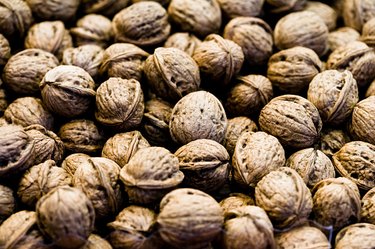
The U.S. Department of Agriculture's Plant Hardiness Zone Map helps gardeners determine which nut trees can grow in the climate conditions particular to their region. Zone 9 encompasses parts of the Southern United States, from Florida and Texas to Arizona and California, as well as Hawaii. To thrive in zone 9, nut trees must tolerate average annual low temperatures to 20 degrees F and tolerate summer heat.
Walnuts
Video of the Day
The black walnut (Juglans nigra) is hardy in zones 4 to 9. Black walnut trees grow from 70 to 100 feet tall with a similar spread. These North American natives have a large, open canopy and grow best in sun and moist, well-drained soil, though they tolerate drought. The black walnut produces edible, oily seeds encased in thick, yellow to green husks. Recommended cultivars for nut cultivation include the "Elmer Meyers" and "Sauber No. 1," both known for prolific production and good cracking quality, and "Thomas," which is well-adapted to Zone 9 conditions.
Video of the Day
Carpathian or English walnut trees (Juglans regia "Carpathian") can also grow in Zone 9 and thrive in sites with acidic soils. This species is susceptible to walnut blight, so choose resistant cultivars such as "Reda" or "Hansen."
Hickory
The shagbark hickory (Carya ovata) produces sweet nuts and grows best in sun to partial shade. Shagbark hickories tolerate a variety of soils, including clay. They produce sweet, teardrop-shaped nuts enclosed in a light husk. Recommended cultivars for high-quality, abundant crops include the "Grainger," "Silvis 303" and "Wurth."
The pignut hickory (Carya glabra) grows to 60 feet with a 40-foot spread. These fast-growing trees prefer sun to partial shade and tolerate a range of soils. Their nuts are edible but tend to be bitter.
Pecan
The pecan (Carya illinoinensis) is hardy in Zones 5 to 9. In warm climates, the pecan grows up to 140 feet tall with a slightly narrower spread. The pecan grows best in sites with sun to partial shade and moist, well-drained soil; it does not tolerate poorly drained soils. Pecan trees require spacing of at least 35 feet between trees and 20 feet from structures to thrive.
Pecans produce red-brown nuts with sweet, ridged seeds. Recommended cultivars for nuts with high oil content and high production include "Greenriver," "Kanza" and "Major."
Pistachio
Certain varieties of cold-hardy pistachio (Pistacia spp.) can grow in Zone 9 conditions, but they may take up to five years to bear fruit. These heat-tolerant trees thrive in warm sites with full sun and sandy, well-drained loam. Pistachio trees grow between 20 and 30 feet tall. Though they tolerate drought, irrigate regularly during the growing season for better nut production. Recommended cultivars for Zone 9 include "Kerman" and "Sfax."
- USNA; USDA Plant Hardiness Zone Map
- University of Kentucky; Nut Tree Growing in Kentucky; Joseph G. Masabni et al.
- University of Florida: Trees of Florida Common Names
- NC State University; Trees; Erv Evans
- New Mexico State University; Growing Pistachios in New Mexico; Esteban Herrera
- Aggie Horticulture: Fruit Gardening in Texas
- Texas Cooperative Extension; Recommended Fruit, Nut and Berry Cultivars ...; Nancy Roe et al.